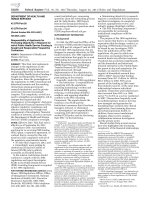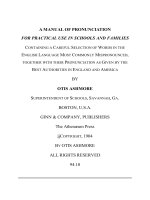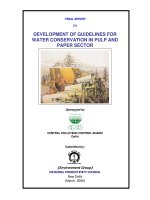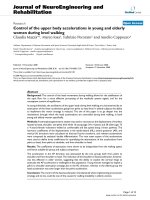- Trang chủ >>
- Khoa Học Tự Nhiên >>
- Vật lý
microstructure control of wo3 film by adding nano-particles of sno2 for no2 detection in ppb level
Bạn đang xem bản rút gọn của tài liệu. Xem và tải ngay bản đầy đủ của tài liệu tại đây (413.52 KB, 4 trang )
Procedia
Chemistry
www.elsevier.com/locate/procedia
Proceedings of the Eurosensors XXIII conference
Microstructure control of WO
3
film by adding nano-particles of
SnO
2
for NO
2
detection in ppb level
Kengo Shimanoe
a
*, Aya Nishiyama
b
, Masayoshi Yuasa
a
, Tetsuya Kida
a
,
Noboru Yamazoe
a
a
Faculty of Engineering Sciences,Kyushu University
b
Interdisciplinary Graduate School of Engineering Sciences, Kyushu University,
6-1 Kasuga-koen, Kasuga, Fukuoka 816-8580, Japan
Abstract
To fabricate more excellent NO
2
sensor with high sensor response and good linearity between the sensor response and NO
2
concentration, the microstructure of WO
3
lamellae was controlled by adding nano-particles of SnO
2
. It was found that the
sintering of WO
3
lamellae was inhibited by adding nano-particles of SnO
2
. The device using WO
3
lamellae added a small amount
of SnO
2
nano-particles had the highest sensor response, exhibiting a high sensor response (S = 60-540) even to dilute NO
2
(100-
1000 ppb) in air at 200°C.
Keywords: Gas sensors, Microstructure control, Lamellar, WO
3
, NO
2
, SnO
2
1. Introduction
It is well known that WO
3
is a semiconductor material to detect NO
2
gas and that the morphology and size of
particles composing the sensing layers play an important role in determining the sensing properties. Previously we
reported that NO
2
sensor using nano-sized WO
3
lamellae shows a high NO
2
sensitivity [1-5]. It was found that the
sensor response was significantly increased with a decrease in the thickness of the WO
3
lamellae and was well-
correlated with its thickness. Another important feature of the devices was the porous microstructure of the sensing
layer packed with WO
3
lamellae with a high anisotropic shape. A sufficiently high sensor response was obtained,
even to 10 ppb NO
2
in air, when WO
3
lamellae with ca. 30 nm in thickness and 1 μm in lateral dimension were used
for the sensing film. In addition, the acidification of NaWO
4
with a strong acid solution produced lamellar-
structured WO
3
particles with 100-350 nm in lateral size and 20-50 nm in thickness, resulting in excellent NO
2
sensing properties (S = 150 against 500 ppb NO
2
in air) at the low temperature of 200°C. On the other hand,
however, the linearity between the sensor response and the NO
2
concentration was not well understood. It is
sometimes observed that the sensor response showed a tendency to be saturated with increasing NO
2
concentration.
Such saturation seems to be owing to that the lamellae particles agglomerated heavily by sintering were dispersed
* Corresponding author. Tel.:+81-92-583-7876; fax:+81-92-583-7538.
E
-mail address:
1876-6196/09/$– See front matter © 2009 Published by Elsevier B.V.
doi:10.1016/j.proche.2009.07.053
Procedia Chemistry 1 (2009) 212–215
Fig. 1 FE-SEM images of the surface for thick films of WO
3
(a), WO
3
-SnO
2
(1:0.01) (b) and WO
3
-SnO
2
(1:0.1) (c) calcined at 300°C.
C.
into the sensing film. In this study, in order to extend the detectable concentration range by improving the sensor
resp
onse at high NO
2
concentration, we investigated the microstructure control of WO
3
film by adding nano-
particles of SnO
2
.
2. Experimental
Sol of WO
3*
2H
2
O with lamellar-structure was prepared by the acidification of NaWO
4
with a strong acid solution
(H
2
SO
4
at pH = -0.8) [5]. On the other hand, sol of crystalline SnO
2
with mean grain (crystallite) size of 7 nm was
prepared by hydrothermal treatments [6]. Both sols were mixed together with W:Sn=1:0-0.1 in molar ratio and
stirred for 24 h. The mixed sols were washed with distilled water by centrifugation. The obtained precipitates were
mixed with water to form a paste. The resulting paste was screen-printed on an alumina substrate equipped with a
pair of comb-type Au microelectrodes (line width: 180 μm; distance between lines: 90 μm; sensing layer area: 64
mm
2
). The paste deposited on the substrates was calcined at 300-500°C for 2 h in air to form a sensing layer of
SnO
2
-dispersed WO
3
via the dehydration of the precursor, WO 2H
3* 2
O.
The surface morphology of the samples was analyzed with a field emission scanning e
lectron microscope (FE-
SEM). The thickness of the films was estimated to be 15-25 μm by FE-SEM observations. The crystal structure
and specific surface area of the samples were measured using an X-ray diffractometer (XRD)
with copper Kα
radi
ation and a BET surface area analyzer, respectively. The NO
2
sensing properties of the devices were examined
at an operating temperature of 200°C in a concentration range of 50 to 1000 ppb in air. Measurements were
performed using a conventional gas flow apparatus equipped with an electric furnace at a gas flow rate of 0.1 dm
3
/
min. The sensor response (S) was defined as the ratio of resistance in air containing NO
2
(R
g
) to that in dry air (R
a
)
(S = R
g
/R ).
a
3. Results and Discursion
Figure 1 shows FE-SEM images of the surface for thick films of WO
3
(a), WO
3
-SnO
2
(1:0.01) (b) and WO
3
-SnO
2
(1:0.1) (c) calcined at 300°C. The morphology of the lamellar particles seems to differ a little depending on amount
of adding SnO
2
. In the case of only WO
3
, comparatively large agglomerated particles are seen. However by adding
SnO
2
nano-particles, the particle size was still kept small although the thickness of lamellae was seen as it increased.
Table 1 shows specific surface area for each sample. By addition of a small amount of SnO
2
nano-particles, it is
found that the sintering of WO
3
lamellae was controlled and the porosity was kept as that result. It can be
considered that SnO
2
nano-particles were inserted between the thin WO
3
lamellae and they played a part in
inhibiting grain growth of WO
3
.
(a)
(b)
(c)
Table 1 Specific surface area of WO
3
-SnO
2
based samples calcined at 300°
K. Shimanoe et al. / Procedia Chemistry 1 (2009) 212–215
213
Figure 2 shows the sensor response as a function of NO
2
concentration at 200°C. In the figure, the properties of
sensor prepared through an ion-exchange method also indicated for comparison. These devices also responded to
dilute NO
2
and showed a sufficient ability to detect ppb level NO
2
in the atmosphere. Especially the device using
WO
3
lamellae added SnO
2
nano-particles indicates excellent sensor response. However, the sensor response of the
devices differed depending on amount of adding SnO
2
. The sensor fabricated with WO
3
-SnO
2
(1:0.01) showed the
best NO
2
response, but the device could not measure high concentration because the electric resistance was as high
as exceeding a measurement limit. Such high sensor response can be explained from the viewpoint of the specific
surface area as shown in Table 1. The sensor fabricated with WO
3
-SnO
2
(1:0.01) has more porous microstructure,
as compared with other devices. It is because the agglomeration of lamellae by sintering was inhibited by adding
nano-particles of SnO
2
. However the amount of addition of SnO
2
nano-particles seems to have the most suitable
value. The sensor response, when the amount of addition increased, lowered like a case of (b) in Fig. 2, although it
was more sensitive than the device without adding SnO
2
nano-particles. In addition, the excessive amount of
addition seems to make linearity between the sensor response and the NO
2
concentration poor.
In order to confirm the linearity between th
e sensor response and the NO
2
concentration for the sensor fabricated
with WO
3
-SnO
2
(1:0.01), the calcination temperature was elevated. Figure 3 shows the sensor response as a
function of NO
2
concentration at 300°C for the devices calcined at 400 and 500°C. The sensing properties were
measured at 300°C to restrain electric resistance in less than a measurement limit. It was found that the sensor
response decreased with increasing the calcination temperature. It can think about such a tendency that WO
3
particles grow due to the rise in calcination temperature. However though the calcination was made in high
temperature, the linearity between the sensor response and the NO
2
concentration was clearly observed for each
device. This result means that the sensor fabricated with WO
3
-SnO
2
(1:0.01) holds porous structure still and fully.
If Au electrodes for measurement can be optimized by using MEMS technology to reduce the electric resistance,
more excellent sensor, which can detect NO
2
of the wide concentration range, would be obtained at operating
temperature of 200°C.
Fig. 2 Sensor response as a function of NO concentration at 200°C for the devices using
2
-SnO (1:0.01), (b) WO -SnO (1:0.1), (c) WO by acidification method, and (a) WO
3 2 3 2 3
by ion-exchange method. These devices were calcined at 300°C. (d) WO
3
K. Shimanoe et al. / Procedia Chemistry 1 (2009) 212–215
214
Fig. 3 Sensor response as a function of NO concentration at 300°C for the devices
2
-SnO (1:0.01)) calcined at (a) 400 and (b) 500°C (WO
3 2
4. Conclusions
To extend the detectable concentration range by improving the sensor response at high NO
2
concentration, the
microstructure control of WO
3
film was investigated by adding nano-particles of SnO
2
. It was found that the
developed devices can detect NO
2
high-sensitively in a wide concentration range of 50-1000 ppb.
Acknowledgements
This work was financially supported in part by NISSAN SCIENCE FOUNDATION.
References
1. Y G. Choi, G. Sakai, K. Shimanoe, N. Miura, N. Yamazoe, Preparation of aqueous sols of tungsten oxide dehydrate from sodium
tungstate by an ion-exchange method, Sens. Actuators B, 87 (2002) 63-72.
Choi, G. Sakai, K. Shimanoe, Y. Teraoka, N. Miura, N. Yamazoe, 2. Y G
. Preparation of size and habit-controlled nano crystallites of
tungsten oxide, Sens. Actuators B, 93 (2003) 486-494.
Choi, G. Sakai, K. Shimanoe, N. Miura, N. Yamazoe, Wet process-prepared thick films of WO for
NO sensing, 3. Y G.
3 2
Sens.
Actuators B, 95 (2003) 258-265.
Choi, G. Sakai, K. Shimanoe, N. Yamazoe, Wet process-based fabrication of WO t
hin film for NO detection, 4. Y G.
3 2
Sens. Actuators
B, 101 (2004) 107-111.
5. T
.Kida, A.Nishiyama, M.Yuasa, K.Shimanoe, N.Yamazoe, Highly sensitive NO
2
sensors using lamellar-structured WO3 particles
prepared by an acidification method, Sens. Actuators B, 135 (2009) 568-574.
6. D.
D. Vuong, G. Sakai, K. Shimanoe, N. Yamazoe, Preparation of grain size-controlled tin oxide sols by hydrothermal treatment for
thin film sensor application, Sens. Actuators B, 103 (2004) 386-391.
K. Shimanoe et al. / Procedia Chemistry 1 (2009) 212–215
215









